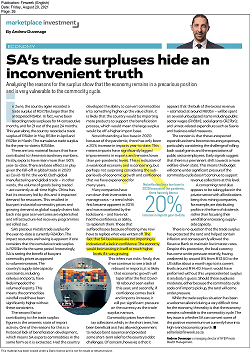SA’s trade surpluses hide an inconvenient truth
Analysing the reasons for the surplus show that the economy remains in a precarious position and is very vulnerable to the commodity cycle.

In June the country once again recorded another trade surplus of R57.7 billion, larger than the anticipated R54 billion surplus. In fact, we’ve been recording trade surpluses for 14 consecutive months, and a surplus in 21 out of the past 24 months. This year alone the country recorded a trade surplus of R54 billion in May, R51 billion in April and R52 billion in March. Its cumulative trade surplus for the year to date is R255 billion.
There are two material factors that have contributed to these extraordinary numbers. Firstly, exports have risen more than 50% year-to-date. There are base effects in play given the fall off in global trade in 2020 as Covid-19 hit the world. Both global manufacturing and global trade – in other words, the volume of goods being traded – are currently at all-time highs. China, in particular, has had its recovery led by this and this has impacted demand for resources. This resulted in buoyant industrial commodity prices and growing demand as global supply chains kick back into gear as inventories are replenished and infrastructure led recovery programmes are rolled out.
South Africa’s precious metals trade surplus for the year-to-date is currently R240 billion. The impact that resources are having is apparent if one considers that the cumulative trade surplus is R255 billion for the same period.
Interestingly, South Africa is seeing the benefit of buoyant commodity prices as opposed to volume increases. The country’s supply side capacity constraints, including constraints at our rail and ports, have in all likelihood impeded the volume of exports. What this means is that the commodities windfall could have been significantly higher had these constraints not been in place.
The second factor contributing to our extraordinary trade surplus figures is the anaemic state of import activity for South Africa. One of the reasons for this is a historical lack of beneficiation development which means South Africa exports commodities in the same form as they are extracted. Had the country developed the ability to convert commodities into something higher up the value chain it is likely that the country wold be importing more products to support the beneficiation process. This would mean the large surplus would be off a higher import base. In other words, low imports are not just the result of an anaemic economy but also a lack of political will to develop a more sophisticated economy.
Notwithstanding a low base in 2020 as a result of the pandemic, there has only been a 20% increase in imports year to date. This means that imports have significantly lagged improvements in exports and remains lower than pre-pandemic levels.
This is indicative of a weak local economy and is concerning, but perhaps not surprising considering the sub-par levels of economic growth and confidence that we have experienced for many years.
Many companies have run down their inventories to manage costs - a trend which first became apparent in 2019 and was exacerbated by the lockdowns – and have not had the confidence, or ability, to replenish them. Those that suffered losses as a result of looting may now have to replace what was written off.
The fact that South African businesses are not importing is indicative of a lack in confidence. The economy would be investing in itself at much higher levels if it was growing.
This infers two risks: firstly, that if we continue to see a lack of rebound in imports, it is likely that economic growth will taper post the first Covid rebound seen earlier this year; and secondly, if confidence comes back and imports increase it will put significant pressure on the currency as the trade surplus narrows.
Commodity prices have driven tax collections which, in the short term, has been beneficial as it has allowed government to reduce bond issuance and provided some short-term relief to the debt challenges the country faces. Of concern, however, is that it appears that the bulk of the excess revenue – estimated to be in the region of R60 billion – will be spent on a number of unbudgeted items including public servant wages (R18 billion); social grants (R27 billion); and unrest related expenditure such as SASRIA and business relief measures.
The concern is that these unexpected expenditure items become recurring expenses, particularly considering the challenge of rolling back social grants and the expectations of public servants. Early signals suggest are that there is a permanent shift towards a more welfare-driven state. This means the budget will come under significant pressure if the commodity cycle doesn’t continue to support revenue collections at this level. Another concern is that the tax windfall is not being spent on economic capacity generating initiatives.
Another concerning trend appears to be taking place in the private sector with all indications being that mining companies, for example, are distributing profits in the form of dividends rather than focusing their windfall on increasing supply side capacity.
There is no question that the trade surplus has protected the Rand and helped contain inflation and consequently allowed the South African Reserve Bank to maintain low interest rates. Despite this protection the local currency has come under pressure recently having weakened by around 8% from R13,50 to the US dollar about a month ago to its current levels. How it would have performed without this unprecedented surplus is anybody’s guess.
Should these surpluses moderate, either because the commodity cycle cools or if imports pick up, the Rand will come under pressure.
While the trade surplus situation has been a welcome tailwind during a very difficult time for the economy, the reality is that the economy remains vulnerable to the commodity cycle. The key issue is whether South Africa can convert some of the positive momentum we currently have into high trend economic growth.
|
This article was written exclusively for Finweek Magazine. It was published in the |
|
 |
 |






.jpg?sfvrsn=3ccd9277_0&size=350)

.png?sfvrsn=38ac0893_0&size=350)

































